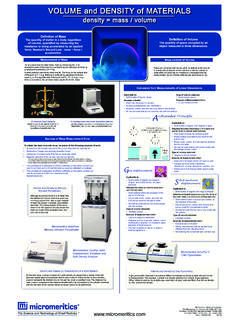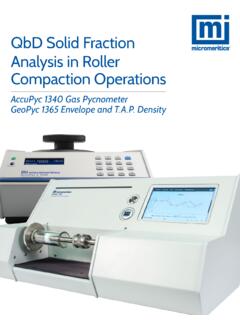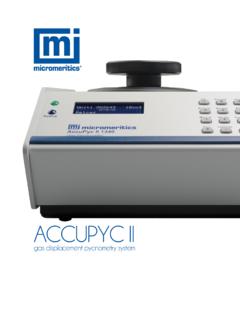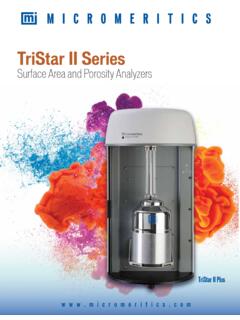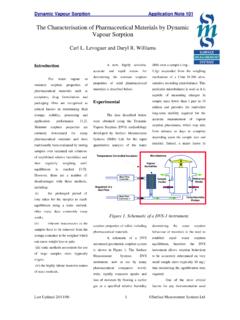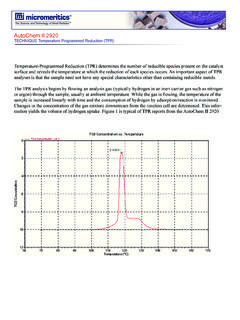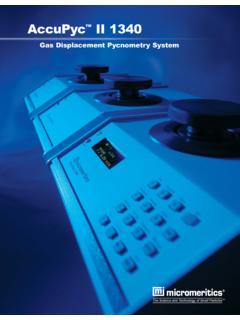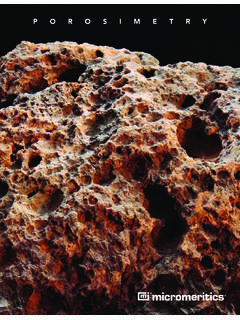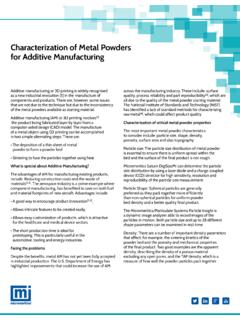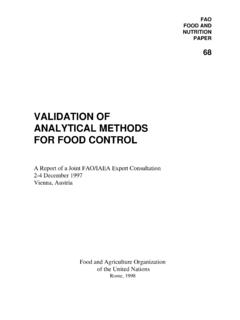Transcription of AN INTRODUCTION TO CHEMICAL ADSORPTION …
1 MIC Technical Publications January 2003 INTRODUCTION to CHEMICAL ADSORPTION analytical Techniques and their Applications to Catalysis Paul A. Webb Micromeritics Instrument Corp., Norcross, Georgia 30093 Abstract The CHEMICAL ADSORPTION isotherm reveals information about the active surface of a material and has been em-ployed for many years as a standard analytical tool for the evaluation of catalysts. Temperature-programmed reac-tion techniques have emerged from the 1950 s as an indispensable companion to chemisorption isotherm analyses in many areas of industry and research. This paper provides an INTRODUCTION to these analytical techniques. Keywords: CHEMICAL ADSORPTION , temperature programmed reactions, TPD, TPR, TPO, catalyst 1.
2 INTRODUCTION Optimum design and efficient utilization of cata-lysts require a thorough understanding of the surface structure and surface chemistry of the catalytic mate-rial. CHEMICAL ADSORPTION (chemisorption) analyses can provide much of the information needed to evaluate catalyst materials in the design and produc-tion phases, as well as after a period of use. The re-quired analytical equipment can be relatively inex-pensive, simple to operate, and fast compared to al-ternate equipment capable of obtaining the same in-formation. 2. Differentiating physical and CHEMICAL adsorp-tion A solid material usually exhibits a heterogeneous distribution of surface energy.
3 Gas, vapor, or liquid molecules may become bound to the surface if they approach sufficiently close to interact. The discus-sions in this paper are confined to the ADSORPTION (and desorption) of gases or vapors on (or from) solid sur-faces. The solid is called the adsorbent; the gas or vapor molecule prior to being adsorbed is called the adsorptive and while bound to the solid surface, the adsorbate. Physical ADSORPTION is the result of a relatively weak solid-gas interaction. It is a physical attraction resulting from nonspecific, relatively weak Van der Waal's forces and ADSORPTION energy usually not ex-ceeding 80 kJ/mole, with typical energies being con-siderably less.
4 Physically adsorbed molecules may diffuse along the surface of the adsorbent and typi-cally are not bound to a specific location on the sur-face. Being only weakly bound, physical ADSORPTION is easily reversed. ADSORPTION also can result in a surface complex, a union much stronger than a physical bond with heats of ADSORPTION up to about 600 kJ/mole for C-N bonds and 800 kJ/mole for CHEMICAL bonds. A CHEMICAL bond involves sharing of electrons between the ad-sorbate and the adsorbent and may be regarded as the formation of a surface compound. Due to the bond strength, CHEMICAL ADSORPTION is difficult to reverse. Physical ADSORPTION takes place on all surfaces provided that temperature and pressure conditions are favorable.
5 Chemisorption, however, is highly selec-tive and occurs only between certain adsorptive and adsorbent species and only if the chemically active surface is cleaned of previously adsorbed molecules. Under proper conditions, physical ADSORPTION can result in adsorbed molecules forming multiple layers. Chemisorption, in the typical case, only proceeds as long as the adsorptive can make direct contact with the surface; it is therefore a single-layer process. Exceptions can exist if the adsorptive is highly polar such, NH3 being an example. Both physical and CHEMICAL ADSORPTION may occur on the surface at the same time; a layer of molecules may be physically adsorbed on top of an underlying chemisorbed layer.
6 The same surface can display physisorption at one temperature and chemisorption at a higher tempera-ture. For example, at liquid nitrogen temperature (77 K) nitrogen gas is adsorbed physically on iron but at 800 K, an energy level too high for physical ADSORPTION bonds, nitrogen is adsorbed chemically to form iron nitride (Moore). 3. General applications of gas sorption as analyti-cal tools A variety of surface features can be determined from observations of the ADSORPTION process. The quantity of molecules taken up by a surface depends on several variables including temperature, pressure, surface energy distribution, and the surface area and porosity of the solid.
7 The relationship between the quantity of molecules adsorbed and the pressure at INTRODUCTION TO CHEMICAL ADSORPTION analytical TECHNIQUES AND THEIR APPLICATIONS TO CATALYSIS -2- constant temperature is called the ADSORPTION iso-therm. Physical ADSORPTION and desorption isotherms are important in characterizing the overall surface. The slightest change in the shape of the plotted isotherm is indicative of a particular surface feature. Analyses of physical ADSORPTION isotherm data reveal the total surface area, mesopore and micropore volume and area, total pore volume, the distribution of pore vol-ume and area by pore size, and surface energy distri-bution.
8 Thus, physical ADSORPTION is an important tool in the study of catalysts, particularly in evaluating the support structure. The CHEMICAL ADSORPTION isotherm also evaluates the surface, but is selective in that it only probes the active areas those capable of forming a CHEMICAL bond with the adsorptive gas or vapor. This selectiv-ity involves both the probe molecule and the molecu-lar or atomic composition of the active material, so the choice of probe molecules is much more impor-tant in chemisorption tests. Although isothermal chemisorption tests are important in characterizing active surfaces, temperature-programmed tests are even more so.
9 The basic form of data produced by these tests resembles a chromatogram of temperature versus quantity desorbed. 4. Catalyst Basics A catalyst affects the rate of a CHEMICAL reaction. Rate' is the most important word in this description because a catalyst cannot induce a reaction that is not permissible under the laws of thermodynamics. A catalyst only can increase the rate at which the reac-tion approaches equilibrium. Heterogeneous catalysts include metals, metal oxides and solid acids. Pure metals may be employed as solid catalysts, or may be dispersed as small grains on the surface of a supporting material such as TiO2, ZrO2, Al2O3, or SiO2.
10 The preparation of a sup-ported catalyst involves selecting precursors of the active components and any necessary promoters and mixing them in a solvent. The mixture forms a pre-cipitant, or is used to coat an inert carrier, or is used to impregnate a carrier. Ultimately, the active metal or precursor is dispersed on the carrier. The product is dried, mixed with a binder or forming agent, then ground, pelletized, extruded, or otherwise shaped. Finally, the material is calcined and activated by oxi-dation, reduction, or other means. One type of unsupported catalyst is composed of pure metal. Raney metal catalysts, for example, are pre-pared by dissolving an aluminum-nickel alloy in a solution of sodium hydroxide, which dissolves the aluminum component.

